I
have always found this YouTube clip of Franklin Delano Roosevelt
extremely fascinating. It appears to have been taken from a
Yazoo DVD entitled Times
Ain't Like They used to Be-Early Rural and Popular Music from
Rare Original Film Masters. You'll notice that when
to film begins, the banjo player to the right of FDR asks "Governor,
is there a special piece you want us to play?" He doesn't
call him "Mr. President." That's because the film
was made on January 26, 1933. Roosevelt had already been elected
to his first term in November, but it would be five more weeks
before his inauguration in early March, when he would deliver
his famous line, "We have nothing to fear but fear itself."
At this time, however, he was still the Governor of New York
state, probably taking a much needed break after a very hard
fought presidential election. Herbert Hoover was still officially
in the White House, though yesterday's news. This would be the
last time a president would be inaugurated in March. The Twentieth
Amendment was to be ratified later in 1933, which moved up the
date to January 20th.
The film was made
at the Roosevelt's retreat in Warm Springs, Georgia, near Pine
Mountain, just south of Atlanta. While he had been coming to
Warm Springs since 1924, where the naturally warm spring waters
gave him some improvement for his polio, the building which
came to be known as the "Little White House" had just
been constructed the previous year, during the election campaign.
It looks like they set up two separate shots for the Soldier's
Joy short, and you can see the house portico very clearly in
the long shot:
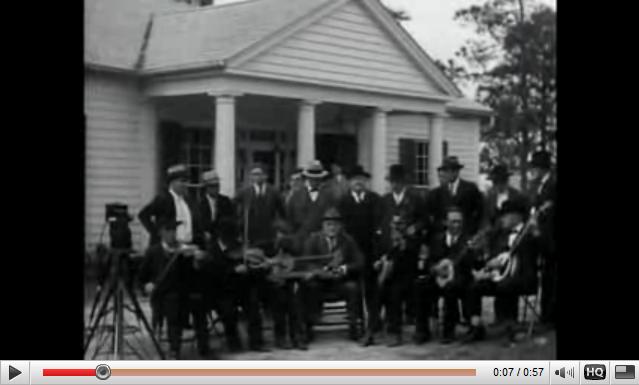
Bun Wright's Fiddle Band playing Soldiers Joy
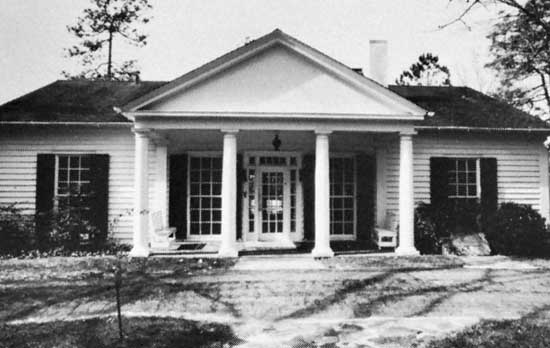
The Little White House, at Warm Springs
The character to
the left of Roosevelt is playing on a Gibson harp guitar. In
the limited close up shots which include this musician, you
never see him tickle the extra strings. I wonder if they were
just supposed to ring in sympathy, or if there was an established
technique for incorporating them into a piece.

Starting at .33
or so, the camera pans across the line of musicians, ending
just at it gets to the last picker, the one with the resonator
banjo. It sure looks like a Gibson to me, but the frame below
is the very last one in the sweep, and it stops before you see
the peghead. One interesting thing, all three banjo pickers
appear to me to be playing in an up-picking two finger style,
not a clawhammer adherent among them. The first might be playing
clawhammer style with a middle finger lead, but it looks to
me more like he is picking lead with his index finger, then
brushing with his middle, or maybe middle and ring. The other
two have their right hands anchored, and are picking up with
the index. More proof that it is a myth that clawhammer style
was the predominant old time banjo picking style.
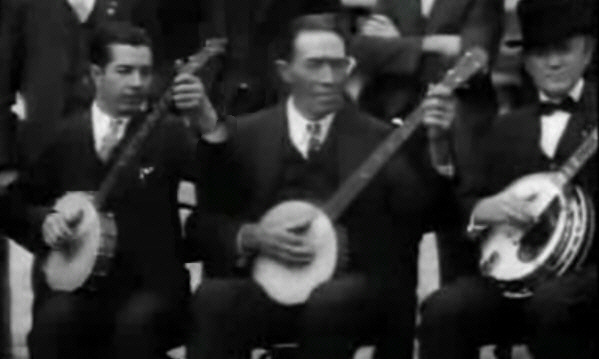
Okay, now I am going
to really go out on a limb. I think the Mastertone picker might
be Fate Norris, the banjo picker who played with the pioneer
old time band, Gid Tanner and the Skillet Lickers. Norris lived
in Resaca, Georgia, about 120 miles north of Warm Springs. He
left the Skillet Lickers sometime in 1931, and lived close enough
to Warm Springs to make the trip for such a weighty command
performance. I've put the image above next to the famous, but
fuzzy image of the Skillet Lickers. If I'm right, we may know
a little bit more about how he picked, since he is generally
inaudible on the Skillet Licker recordings. I don't know, looks
like the same guy to me...

The film's editor
took some liberties when putting the piece together. At .20,
the woman in the striped shirt and cap standing behind FDR is
not yet in the picture.
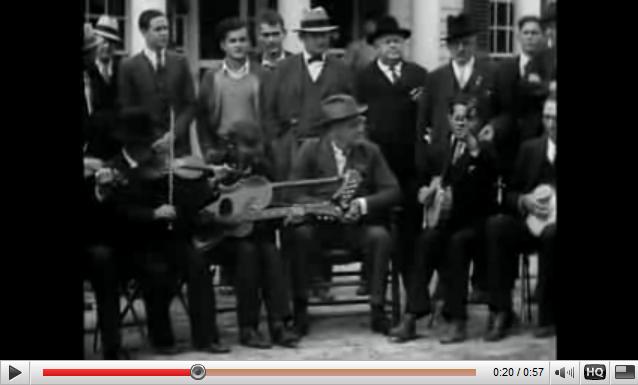
One second later,
she shows up. The image from .25 shows her looking directly
at the camera.
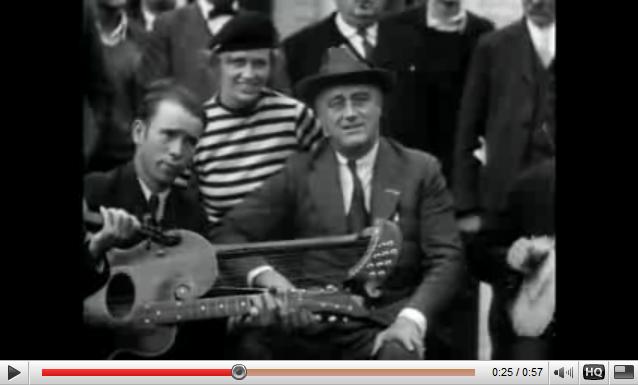
The young woman
is Anna Roosevelt, FDR's only daughter, then 26. Twelve years
later, when her husband was away at war, she moved into the
White House to take over her mother's roll as hostess, due to
Eleanor's frequent travels. Alarmed about both the severe emotional
and physical toll which his presidential responsibilities were
taking on her father, the devoted Anna was to help arrange a
number of clandestine reunions between FDR and an old mistress,
Lucy Mercer Rutherford, in order to bring him comfort. Rutherford
was with the President at the Little White House when he died
in April, 1945, but was spirited away before the press arrived,
to avoid scandal. Eleanor immediately learned of Rutherford's
reemergence in her husband's life, and her daughter's role as
enabler, which led to an estrangement between the two that continued
for many years. Anna died in 1975, at the age of 69.
The day before he
died, FDR spoke to his daughter by telephone. Some local friends,
he told her, including the Mayor of Warm Springs, Frank Allcorn,
had planned a barbeque for him the next day. They were going
to cook him up some Brunswick Stew. There was going to be some
music, he said, including some tunes from his favorite fiddler,
Bun Wright.